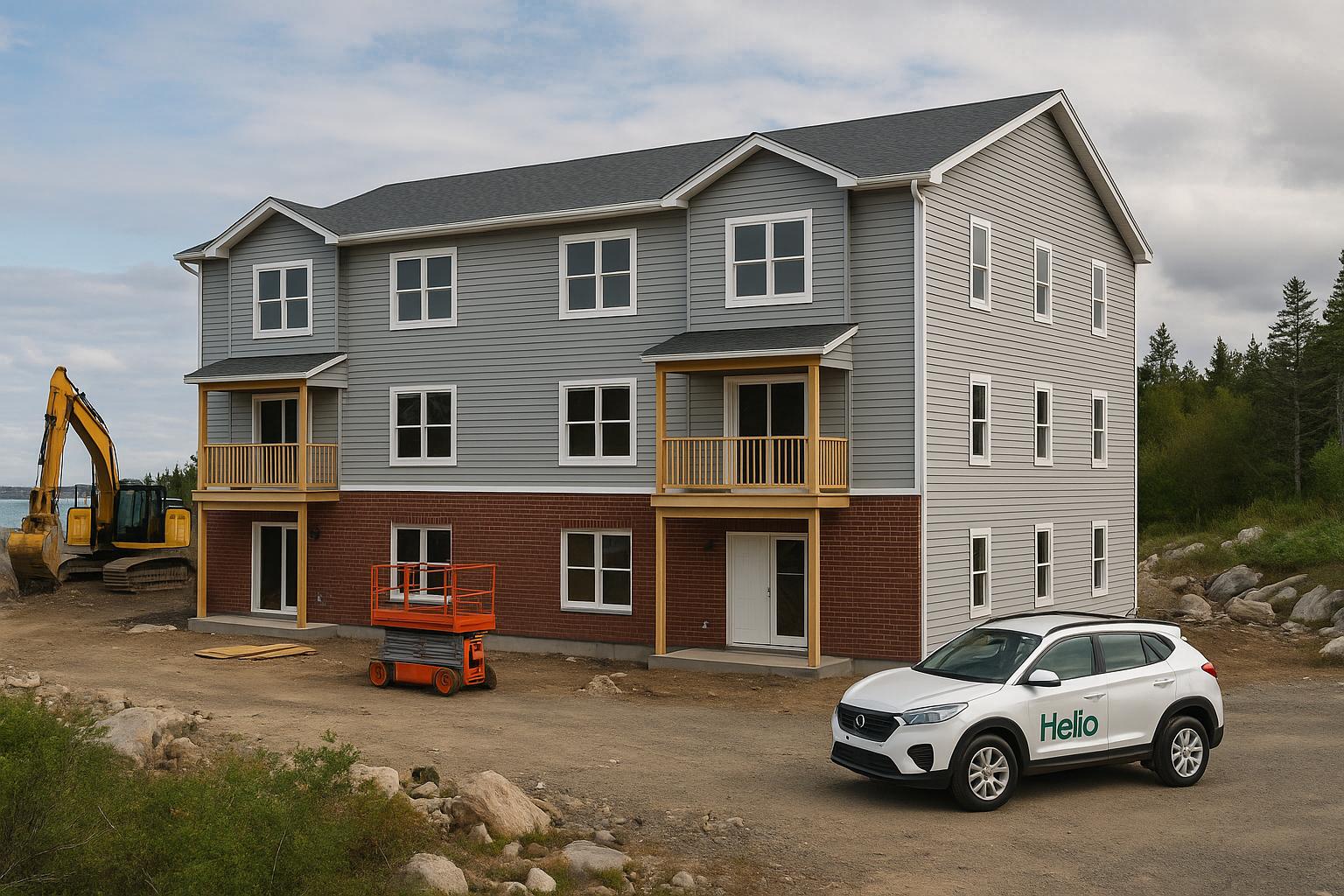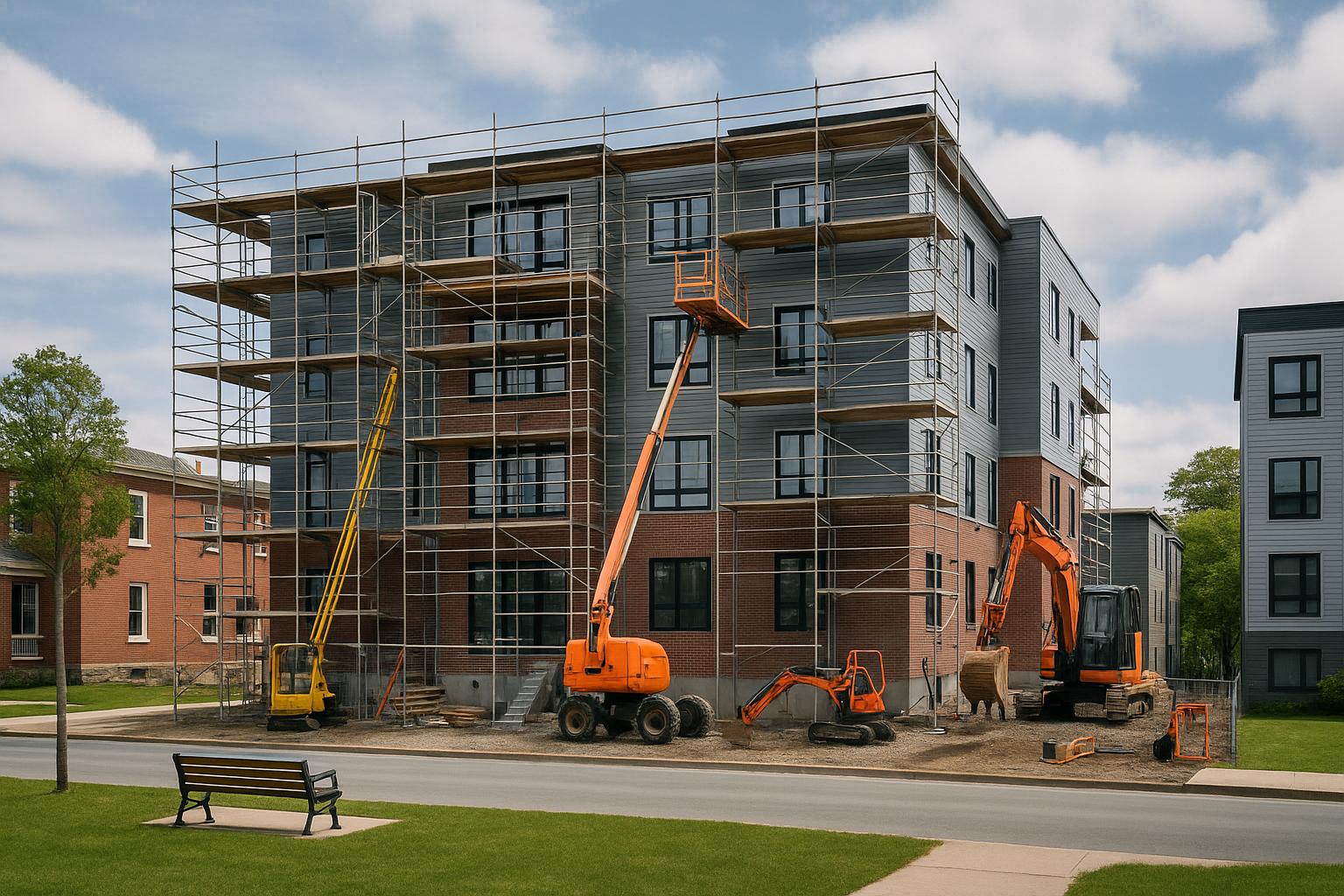When starting a multi-unit rental project in Dartmouth, navigating the Site Plan Approval (SPA) process is a critical first step. SPA ensures your development aligns with Halifax Regional Municipality (HRM) zoning rules, infrastructure needs, and community planning goals. Mismanagement of this process can lead to costly delays and budget overruns.
Key Takeaways:
- SPA involves detailed submissions covering building layout, parking, utilities, and more.
- Property owners, builders, and municipal staff all play roles, but a builder-led approach often works best for efficiency and accountability.
- Integrated builders streamline the process by managing everything in-house, reducing delays and miscommunication.
Choosing an experienced builder to lead your SPA submission ensures smoother approvals, predictable timelines, and fewer surprises. Helio Urban Development, for example, offers fixed-price contracts, completion guarantees, and real-time project updates to simplify the process and keep projects on track.
How Does Site Plan Review Work? - CountyOffice.org
Who's Involved in the SPA Process
The Site Plan Approval (SPA) process in Dartmouth involves a collaborative effort between property owners, municipal staff, and builders to secure the necessary permissions for multi-unit projects.
Roles of Property Owners, Builders, and Municipal Staff
Property Owners: As the primary stakeholders, property owners are responsible for ensuring the SPA gets approved. By setting clear goals and hiring a builder experienced in SPA submissions, they can reduce their involvement in the day-to-day tasks while ensuring the process stays on track.
Municipal Planning Staff: The planning staff at Halifax Regional Municipality assess submissions to ensure they meet zoning bylaws, infrastructure capacity, and community planning policies. While they pinpoint issues and request changes, they don’t offer guidance on how to prepare or adjust submissions.
Builders and Design Teams: Builders handle key deliverables such as architectural plans, engineering studies, surveys, and environmental assessments. This can be done using a traditional approach - hiring separate professionals for each task - or through an integrated design-build team. The latter option streamlines the process by resolving conflicts early, helping to avoid delays and unexpected costs.
This division of responsibilities makes it clear why working with a single, integrated builder can simplify and improve the SPA process.
Multiple Contractors vs. a Single Builder
Using multiple contractors can lead to misaligned deliverables - such as conflicting architectural and engineering inputs - which often result in costly revisions requested by municipal staff. This fragmented method can also create accountability issues and extend the approval timeline.
On the other hand, a single builder managing the entire SPA submission avoids these pitfalls by handling everything internally. With one team overseeing all aspects - from design to infrastructure planning - the process becomes more efficient, reducing delays and ensuring a smoother path to approval.
Who Should Lead SPA Submittals?
Keeping your Dartmouth project on track and within budget hinges on effective management of SPA submittals. The leadership approach you choose - whether builder-led, owner-led, or consultant-led - can significantly shape the outcome. While the Halifax Regional Municipality doesn’t prescribe a single method, the decision can have a major impact on your project's success.
How SPA Leadership Typically Functions in Nova Scotia
In Nova Scotia, SPA submittals can be spearheaded by the owner, a consultant, or the builder. However, many experts now recommend builder-led submissions due to their deeper municipal knowledge and ability to manage projects cohesively [1].
Municipal planning guidelines emphasize the need for complete and organized submissions. This is where seasoned builders shine. Their established connections with municipal staff can also help minimize delays caused by back-and-forth communication, ensuring a smoother approval process.
Why Builder-Led SPA Submittals Work Best
A builder-led approach simplifies the process by centralizing communication through a single point of contact. This reduces confusion and minimizes the risk of costly miscommunications.
Additionally, when builders take the lead, they ensure that approved plans are realistic and align with both construction capabilities and local building practices. This alignment helps avoid the disconnect that often arises when consultants propose solutions that turn out to be impractical or expensive during construction.
Challenges with Owner- or Consultant-Led Submittals
On the other hand, owner- or consultant-led submittals often face issues like fragmented communication and delayed responses, which can lead to missed deadlines and increased costs [1].
A lack of clear accountability can further complicate matters, making it harder to enforce deadlines or resolve problems efficiently. While consultants bring valuable expertise, they may lack the practical construction knowledge needed to effectively bridge municipal requirements with on-site realities. This gap can result in plans that are difficult or costly to implement.
sbb-itb-16b8a48
How Integrated Builders Handle SPA Submittals
Integrated builders bring a structured approach to managing Site Plan Approval (SPA) processes, ensuring that multi-unit projects in Dartmouth meet municipal requirements without unnecessary delays.
SPA Management Process: A Step-by-Step Approach
Integrated builders like Helio start by conducting a feasibility review. This involves assessing the property against Halifax Regional Municipality (HRM) requirements, pinpointing potential challenges, and creating a strategy tailored to the submission.
Afterward, the internal team gets to work preparing all necessary documents simultaneously. This parallel workflow helps avoid the delays that often occur when consultants operate independently.
Early engagement with HRM planning staff is another critical step. By addressing potential concerns upfront, integrated builders reduce the likelihood of extensive revisions during the later stages.
Finally, the builder takes charge of coordinating submissions, managing communications with municipal staff, and handling any required revisions. This approach keeps property owners in the loop without burdening them with technical details.
Simplified SPA Management with a Single Point of Contact
One of the standout benefits of working with an integrated builder is having a single, dedicated contact throughout the SPA process. This simplifies communication and eliminates the confusion that often arises in fragmented projects.
When municipal staff request changes, the builder's team manages the revisions internally. This spares property owners from having to coordinate between multiple advisors. Additionally, internal project management tools are used to track deadlines, requirements, and progress, ensuring decisions are made efficiently and delays are avoided.
Ensuring Compliance with HRM SPA Standards
Integrated builders often have established relationships with HRM planning staff, which can make the SPA approval process smoother. Their history of submitting thorough, high-quality applications means they receive clearer guidance and faster reviews.
To ensure compliance, internal reviews are conducted before submissions are filed. This step focuses on verifying that all required documents - such as application letters, concept plans, engagement summaries, and mobility analyses - are complete and meet HRM standards [2]. Properly prepared documentation avoids delays caused by missing or insufficient materials.
Additionally, integrated builders understand municipal timelines and factor them into construction schedules. By providing realistic approval dates to property owners, they help prevent scheduling conflicts that might arise from unexpected delays. This meticulous process not only speeds up municipal approvals but also ensures accountability, setting the stage for a successful project.
Preventing SPA Delays and Ensuring Builder Accountability
Delays in Site Plan Approvals (SPAs) can disrupt occupancy timelines, strain relationships with investors, and reduce returns on investment (ROI) [3]. Understanding the common causes of these delays is crucial to avoiding them.
Common Causes of SPA Delays
- Permitting challenges: Delays in securing permits - especially when projects span multiple jurisdictions - can halt progress before it even begins or postpone key inspections [3].
- Missed or delayed inspections: Moving forward without all required approvals can lead to stop-work orders or expensive rework [3].
- Coordination issues across trades and phases: When multiple teams work simultaneously, a delay in one area can trigger rework or downtime for others [3].
- Mid-project design changes: Altering designs during construction often results in significant delays [3].
Builders with an integrated approach, like Helio, can effectively address these risks through structured guarantees and efficient project management.
Choosing a Builder Who Takes Full SPA Responsibility
To avoid SPA-related setbacks, select a builder who takes full accountability. Look for these key traits:
- Fixed-price contracts with completion guarantees: Avoid cost-plus contracts that shift financial risk to property owners. Builders with municipal experience specific to Dartmouth and the Halifax Regional Municipality are better equipped to navigate local requirements.
- In-house design expertise: Builders with their own architecture, engineering, and planning teams can prevent delays caused by coordination issues between separate consultants.
- Proven track record: Request references from recent multi-unit projects to confirm the builder’s ability to meet SPA deadlines.
- Transparency and penalties for delays: Builders who implement delay penalties and offer tools like project portals or regular updates demonstrate confidence in their ability to deliver on time.
Helio's SPA Guarantees and Accountability System
Helio Urban Development stands out with its fixed-price construction model set at $160,000 per unit, backed by a six-month completion guarantee. For delays, Helio enforces penalties of up to $1,000 per day, ensuring they remain accountable.
Their integrated approach reduces coordination inefficiencies, which typically cost around $47,000. Transparency is maintained through daily photo updates and a live project portal, providing property owners with real-time insights into progress.
Helio also employs a triple quality verification system. This includes five inspections by Professional Engineers, with the property owner selecting the final inspector, and a two-year warranty to ensure quality beyond basic SPA compliance.
Conclusion: Getting SPA Right for Your Dartmouth Project
Navigating Site Plan Approval (SPA) for a multi-unit project in Dartmouth hinges on partnering with a builder who takes full ownership of the process. The typical fragmented method - where property owners juggle architects, engineers, and contractors - can create unnecessary risks, leading to delays and budget overruns. A unified approach not only keeps things on track but also ensures your project stays predictable and efficient.
Builders who use an integrated approach deliver results you can count on. For example, Ryan Companies, during an acute care hospital expansion, used a design-build model to streamline a five-phase project into just three phases. This adjustment saved three to four months on the schedule. Their proactive preconstruction planning identified potential challenges early, cutting both time and costs as the project progressed.
For property owners in Dartmouth, this kind of integrated approach means dependable occupancy timelines and steady rental income. Builders like Helio, who take total responsibility for SPA submissions, eliminate the confusion and inefficiencies that can cost property owners upwards of $47,000.
With an integrated builder-led model, accountability spans every phase of the project. Key advantages include fixed-price contracts with guaranteed completion dates, in-house design capabilities, and a strong understanding of Halifax Regional Municipality requirements. This approach not only simplifies the process but also sets your project up for success from the start.
FAQs
Why is it beneficial to have your builder handle Site Plan Approval (SPA) submissions in Dartmouth?
Opting for a builder-led approach to SPA submissions in Dartmouth can make the process much smoother and help you sidestep unnecessary delays. Builders who use a design-build model handle everything in-house, ensuring all the necessary documentation meets municipal requirements and reducing the chances of mistakes or oversights.
One of the biggest advantages of this approach is single accountability. Your builder takes full responsibility for managing the entire SPA process. This cuts down on miscommunication, speeds up approvals, and keeps your project timeline on track. For property owners, it means less hassle, fewer unexpected issues, and a quicker, more straightforward path to getting construction approval.
Who ensures compliance with Halifax Regional Municipality (HRM) standards during the Site Plan Approval (SPA) process?
An integrated builder plays a crucial role in ensuring that every aspect of the SPA process aligns with HRM standards. They stay well-informed on the Halifax Land Use By-law, Design Manual, and municipal building codes, ensuring that all project-related documents, designs, and reports meet the required criteria.
By managing everything from preparing submission packages to interpreting municipal guidelines, they simplify the entire process. This thorough attention to detail not only avoids unnecessary delays but also ensures precision, keeping the project on schedule and offering property owners a sense of reassurance.
What issues can arise if property owners or consultants handle SPA submissions themselves?
When property owners or consultants handle Site Plan Approval (SPA) submissions in Dartmouth, they often face delays, higher rejection rates, and unnecessary stress. This is usually due to limited knowledge of municipal requirements and the overall complexity of the process. Without the guidance of a seasoned builder, navigating regulations, working with stakeholders, and addressing potential challenges can feel overwhelming.
These hurdles can result in communication breakdowns and accountability issues, which not only slow down the approval process but also drive up costs. Partnering with a builder who offers integrated design-build services can make a big difference. Their expertise ensures better coordination, smoother submissions, and a more efficient approval process, ultimately saving time and reducing stress.



